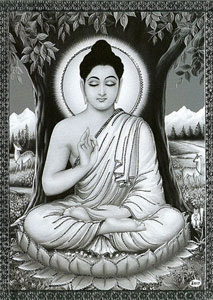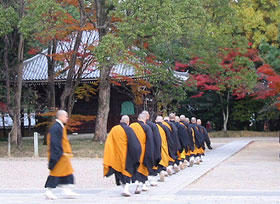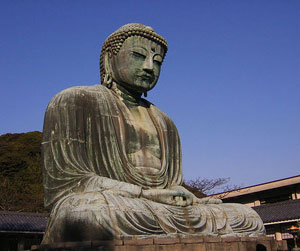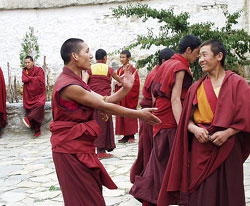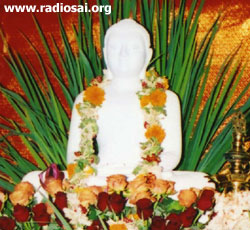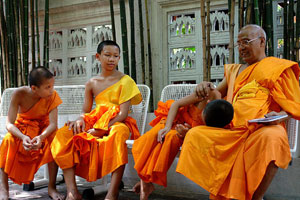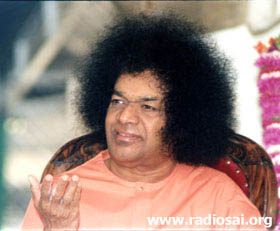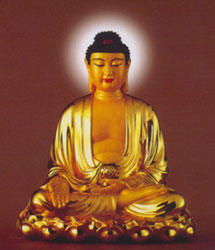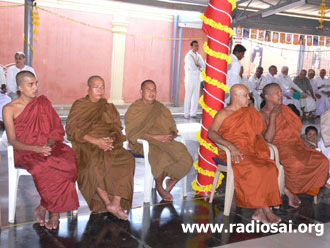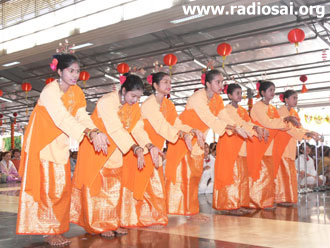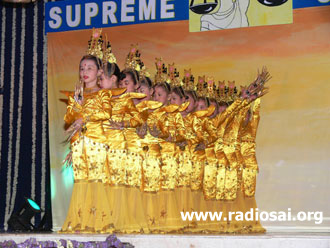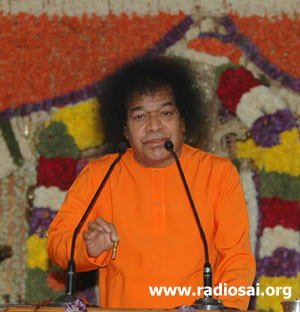| |
FASCINATING BUDDHA
THE LIFE OF BUDDHA
Buddha has fascinated people around the globe for almost 2500 years. Born as a prince in northern India, the Buddha had an incredible destiny ahead of him.
His desire for truth was so powerful that he broke free even from family ties at a young age and abdicated the throne to the Shakya kingdom. Initially his father named him Siddhartha. Later he was called Gautamo Buddha (after his stepmother) or Shakyamuni Buddha (chief of the Shakya family). Buddha means "The Enlightened One".
Born To A Royal Lineage
Buddha was born 2600 years ago in Lumbini in the Shakya state, on the Nepal-India border. Legend says that his family lived in opulence and luxurious palaces. Some days after Buddha’s birth, his mother passed away. Thereafter he was lovingly raised by his stepmother Gautami. Legend also claims that a seer predicted the newborn prince would become either a great king or a revered holy man. |
|
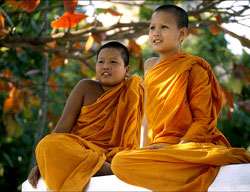 |
| Young novice Buddhist monks watch on as their friends enjoy a game in Thailand |
|
Buddha’s father, King Suddhodana, had an ardent desire for his son to take over the reins of the kingdom. However, he feared the likelihood of Siddhartha renouncing worldly life, so he shielded Buddha from all unpleasant experiences, ensuring that he would be perfectly content with his life. He placed Siddhartha in a palace with servants at his beck and call providing everything he wanted, completely sheltering him from mundane reality. Buddha married and had a son. Nevertheless, despite a luxurious and contented life, at 28 he decided to venture out and see what lay beyond the palace walls.
The Path To Enlightenment
 |
An Old Man |
|
|
Siddhartha witnessed the harsh realities of daily life for the first time. He encountered four people – known as the "four passing sights" in Buddhist scriptures – which turned the young prince's life inside out, eventually prompting him to seek the path of enlightenment.
First he saw a crippled old man, a sick man, and a dead body, and finally a wandering holy man who had transcended the ups and downs of mortal life and was serene.
Prince Siddhartha returned to the palace and contemplated what he had observed. He had been unaware that the King had prohibited anyone old or sick to come into his son's purview, fearing that such images might awaken his latent tendencies towards a renunciate's life. Indeed, these four sights led Siddhartha to the realization that birth, old age, sickness and death come to everyone, not only once, but in a cycle repeated life after life since time immemorial.
Buddha began to consider his entire past. He saw that nothing lasted permanently and nothing bestowed deep and satisfying pleasure. |
At this point let’s read what Swami comments on this topic:
Parents were subjecting their children to various kinds of bonds and making their lives miserable. As soon as the children come of age the parents are keen to get them married. They do not know what kind of happiness he can get from married life. What happiness have they derived from their own married life physically, mentally or otherwise? No person, however intelligent, thinks about this matter. Even eminent scholars do not care to examine whether it is worthwhile pursuing sensuous pleasures instead of seeking what is beyond the senses. Buddha felt intensely unhappy that his parents and others combined to commit him to the bondage of married life. One day at midnight, Buddha left the palace, giving up his wife and young son, Rahul. At the age of 28, he gave up everything and turned a renunciate. (Divine Discourse - 15th May 1997)
Buddha Sacrifices His Luxurious Life to Pursue Self-Enquiry
After reviewing his own life and life in general through self-enquiry, Siddhartha renounced his lavish worldly life, his wife and child, his status and all his privileges. He made this immense sacrifice in order to seek the solutions to the problems of birth, old age, sickness and death and embarked on the quest for escaping the cycle of life and death.
Baba's comments are pertinent here:
Buddha…could not bear to see anyone suffering. He was deeply grieved at the sight of persons afflicted with old age. He was intrigued at the sight of a dead body. None of these natural happenings gave him peace of mind. Buddha considered the movements of the planets and the sun and the stars as natural phenomena. He undertook many spiritual exercises to find out what transcended these natural phenomena. Failing to find the answers by these exercises, he approached many great elders to find the answers. None could give him satisfactory answers. Ultimately he reached Gaya [in Northern India] and sat under a banyan tree to meditate on the problems that worried him. (Divine Discourse - 15th May 1997)
|
|
|
Buddha Practises Asceticism
 |
The Bodhi tree. This may have been the site of the earliest shrine enclosing the actual Bodhi tree relic (the present tree is a later descendant). |
|
|
Siddhartha sat under the banyan tree in search of answers to life's mysteries. Holy men often engaged in a variety of ascetic practices designed to mortify the flesh as it was believed that through enduring pain and suffering, the ātman or ' soul' became free from the cycle of rebirth.
The young seeker proved adept at these techniques and even surpassed his teachers, but after six years of practising asceticism and solitary meditation he was still no closer to his objective of finding a permanent solution to eradicate suffering. So, leaving his teachers behind, he and a small group of companions set out on their own to intensify their austerities.
After a long period of asceticism and almost starving himself to death, Siddhartha began to re-evaluate his path and practice. He determined that the goal was unattainable by either extreme, the austere life or the lavish life. When he abandoned their path and parted from his companions, they warned him that he would fail. Undeterred, he proceeded forward in pursuit of his goal.
The Finding of the Truth – Nirvana
Buddha recollected a childhood memory when he had a profound insight. As he watched his father inaugurate the season's ploughing, he drifted into a natural state of concentration which was refreshingly blissful, in which time seemed to stand still.
Buddha realised that truth is not outside or something accessible through spiritual teachers or special rituals. Truth is inherent in oneself. |
Although all Avathars (divine advents) have been preaching only good things, men today are content to observe their birthdays without following their precepts. Buddha did not attach any importance to yajnas and yaagas and other religious rituals. The reason is he felt that it was more important to ensure that the five sense organs were pure to begin with. Buddha sought to find out why the mind gets disturbed. (Divine Discourse - 15th May 1997)
Regarding this inherent truth, which Buddha called Nirvana, or freedom from illusion, Baba has commented:
But none of these practices could show him the path to Nirvana. Ultimately, he realised that Nirvana lay in making use of the five senses of speech, touch, vision, taste and smell in a sacred manner. He understood that japa, dhyana, yoga, yajna, etc., were mere physical activities. These spiritual practices are needed for those who are attached to the body. (Divine Discourse - 14th Jan 1973)
When Buddha became enlightened, he had the option of leaving this world behind and entering Parinirvana. He reflected upon his awareness: “The truth and the reality of dharma are not easy to understand – only the wise man will understand.” Yet his infinite compassion won out and compelled him to remain on earth in a mortal form so as to help others transcend the cycle of birth and death. |
|
|
THE BUDDHA'S TEACHING – THE MIDDLE PATH
Having known both luxury and austerity, he rejected these extremes and called his teaching, “The Middle Path”. He imparted his wisdom to one and all in a serene and compassionate manner, disregarding all social and hierarchical distinctions.
The following three headings highlight the essence of Buddha’s teachings.
- The Four Noble Truths
- The Three Jewels
- The Noble Eightfold Path
Buddha’s Heritage
Buddha’s heritage is as vibrant as it was 2600 years ago. More than 350 Million people (other statistics account for 700 million) either practice Buddhism or adhere to its precepts.

Buddhism underwent a long transition of change and transformation to now take its place as a contemporary ‘global’ religion. In the east, it gives the cultural foundation for every aspect of life, from childhood to death. In the west, it is commonly perceived as a peaceful and meditative religion.
Common features in all Buddhist lineages -
- Shakayamuni Buddha is the original founder of Buddhism.
- The Three Universal Seals, Four Noble Truths, Eight Fold Path are the basic precepts to all schools of Buddhism
- Threefold training of Precepts, Meditation and Wisdom are universal to all schools.
- The concept of mind over matter. The focus on taming the Mind is fundamental to all schools.
|
|
|
The first three Noble Truths present a diagnosis of why we suffer. The Fourth Noble Truth is the remedy to this suffering. The Three Jewels describe the relationship between the enlightened One (Buddha), the right way of living (Dharma), and the community around us (Sangha).
Through the Noble Eightfold Path Buddha explains why an ethical life is crucial in the practice of his teachings. Comprehending and following the Noble Eightfold Path is the therapy for life’s misery.
THE FOUR NOBLE TRUTHS
The Four Noble Truths present an analytical view of our daily life. Shakyamuni Buddha explains in a scientific way how to find true bliss and why our worldly life is not Life’s ultimate purpose.
The Buddha taught that life was unsatisfactory because of constant craving and desiring but that this condition was curable by following the Noble Eightfold Path.
The Four Noble Truths are:
- Dukkha: All worldly life is unsatisfactory, disjointed and entails suffering.
- Samudaya: There is a cause for suffering, which is attachment or desire rooted in ignorance.
- Nirodha: There is an end to suffering, which is Nirvana.
- Magga: There is a path that leads out of suffering, known as the Noble Eightfold Path.
|
|
|
|
Buddhism teaches that suffering is caused by desire and wants. The central theory of Buddhist philosophy explains that the cause of suffering is Pratītyasamutpāda, which means "the chain of causation", and further more that everything in the world, including the soul, is only relative and momentary. Action is not independent from its cause but depends upon it – hence the fundamental theory of Karma.
When we analyze our own life in this way, we will discover the desires underlying the decisions we made at various junctures on our journey. As long as we deny the eternal truth permeating everything, life will continue to appear as suffering. However, once we grasp that the underlying cause of all our suffering is ignorance, we then have the choice in any given moment to awaken from our slumber and rise above our ignorance. The Buddhist prescription for alleviating and removing suffering is the Noble Eightfold Path. We have to make a permanent decision to orientate ourselves towards the eternal truth.
This decision is known as the “change in the consciousness” (asraya paravrtti) in Buddhism. As long as we are unable or unwilling to observe our own ignorance and recognize it for what it is – a misperception of true reality – we will foolishly hold onto it.
However the moment we perceive this state of ignorance as the basis of our suffering and make a commitment to free ourselves from it, a transformation occurs in our consciousness.
In Buddhist philosophy, hatred, jealousy and greed are the three poisons in our consciousness. Whenever we overcome our ignorance and rise above hatred, jealousy and greed, we are orientating ourselves in a Dharmic direction.
Concerning the role of faith in assuming this right decision, Baba stated:
|
|
|
Japanese Monks walking in one direction |
|
Buddha was born in this sacred land of Bharat. He declared to the world 'Ahimsa paramo dharma' (non-violence is the greatest dharma). He undertook penance for several years, met many noble souls, listened to spiritual discourses, and studied various scriptures. But he was not satisfied. Man aspires for bliss, but how can he attain it? Where there is faith, there is love. Where there is love, there is peace. Where there is peace, there is truth. Where there is truth, there is God. Where there is God, there is bliss. The path of spirituality starts with faith and ends with bliss. Bliss cannot be attained from materialistic pleasures or people of the world. It can be experienced only when the five senses are put to proper use. (Divine Discourse, 30th May 1999)
THE THREE JEWELS OF BUDDHISM
Traditionally, when a person has made this decision and wishes to follow the way of the Buddha he then takes sanctuary in the teachings of Buddha in an act known as “Taking Refuge” in the Three Jewels.
Taking Refuge in the Three Jewels
 |
Wat Phra Si Sanphet
Ayuthaya, Thailand |
|
|
Taking Refuge in the Three Jewels is the foundation of Buddhist religious practice. The Jewels are the Buddha, the Dharma, and the Sangha.
For someone who is seeking to become enlightened, Taking Refuge entails a continuing commitment to pursue illumination by having faith and confidence in the path trod by those dedicated souls who have preceded them.
Many Buddhists take the refuges every day, often more than once, to renew and strengthen their resolve towards liberation. The inward act of taking refuge is always more significant than the external ritual.
In Buddhism, the term "refuge" should not be taken in the sense of "hiding" or "fleeing"; rather, it is conceived of as a homecoming, or place of healing.
A misunderstanding of this has led some Western scholars to erroneously conclude that Buddhism is "a religion for sticking one's head in the sand", whereas practicing Buddhists would assert, to the contrary, the main goal of Buddhism is release from the suffering of cyclic existence not by denial or running away from life but through the elimination of ignorance and the dispelling of illusion in all forms. Some translators also translate it as "taking safe direction". |
Understanding the ‘Middle Path’ correctly, we should not indulge in actions without right motives and we should not go the ascetic way and avoid the world as something evil. The meaning of the ‘Middle Path’ is expressed in Baba’s aphorism, “Head in the forest, hands in the society". This is the balanced path, when we act for the benefit of the world but keep our focus on God. Only then can we “come home” and heal ourselves and others.
In a Buddha Poornima speech, Baba beautifully explained the true meaning of the prayer used in the Three Jewels:
Buddham sharanam gachchaami, Dharmam sharanam gachchaami, Sangham sharanam gachchaami. The real meaning of the prayer is: you must divert your Buddhi (mind) towards Dharma (right conduct). And right conduct should aim at serving society. When this is done, society gets purified. (Divine Discourse, 15th May 1997)
The Buddha presented Himself as a model and appealed to His followers to have faith in His example, as one who was human and successfully transcended the chains of mundane existence. Buddhists believe that there is no otherworldly salvation from one's karma. The suffering caused by the karmic effects of previous thoughts, words and deeds can only be avoided by following the Noble Eightfold Path. The Dharma offers a refuge by providing guidelines for the cessation of suffering and the attainment of enlightenment. The Sangha offers a refuge by preserving the authentic wisdom of the Buddha and by providing further examples of the validity of his teachings.
Jewel One: Buddha
|
Buddha statue in Kamakura, Japan |
|
Shakyamuni Buddha did not claim any superiority over mankind or any gods. He also did not proclaim any divine status for himself. He was himself Dharma (Ultimate Truth) made manifest.
A Buddha is anyone who has fully awakened to the true nature of existence, liberated himself from the cycle of birth, death and rebirth, and has eradicated all negative qualities and developed all positive qualities, including omniscience.
Shakyamuni Buddha as a human being was unique, yet His existence reminds us of our own inner qualities. The German Zen Master Rei Ho Hatlapa Roshi taught that ritualistic prostrations are not performed to another person but are an expression of the reverence to our own inner Buddha qualities as well as to the omnipresent Buddha.
Jewel Two: Dharma
In general, Dharma is the ethical guidelines for the right conduct of a Buddhist. It is not an external frame work but something that comes from within, from the heart. Dharma also relates to the inner connection between everything on an ethical and spiritual level.
Baba points out that a true human being is someone who pursues the path of truth – the Dharmic path, which is comprised of:
Samyak drishti (right vision), samyak bhavam (right feeling), samyak sravanam (right listening), samyak vak (right speech), and samyak karma (right action)…Truth, righteousness and sacrifice should be the way of life…It means:
|
|
Types of Buddhism
Though the above are the common features in all Buddhist lineages, there are also distinctive differences in the paths that are followed.
Theravada Buddhism is mainly practiced in Southern Asia, Mahayana Buddhism, in Northern Asia. Theravada Buddhism (small vehicle) emphasises the personal individual goal for self liberation.
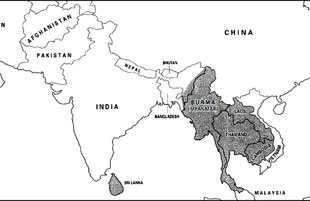 |
Regions practising Theravada Buddhism |
Mahayana Buddhism (big vehicle), on the contrary, focuses on universal self liberation. It is very important for them to help other sentient beings to attain self liberation.
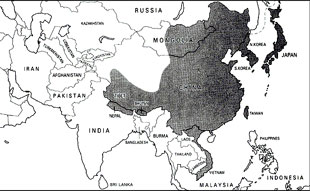 |
Regions following Mahayana Buddhism |
Theravada scriptures are imparted in Pali, and Mahayana, in Sanskrit, or languages like Chinese, Japanese or Tibetan. The Mahayana mythology is much more extensive than the Theravada mythology.
|
|
buddhi (intellect) should follow the path of dharma, and dharma should be fostered in society. Only then will the country prosper. This is also the inner meaning of the word SAI. S denotes spiritual change, A denotes association (social) change, and I denotes individual change. Man's mind will become pure and sacred only when these three changes take place. (Divine Discourse, 30th May 1999)
The Love in all living beings is the countenance of the Dharma, which appears between people when they interact in a Dharmic way. Love is attainable by Ahimsa (non-violence), the highest value in Buddha’s teachings as Baba has declared:
Buddha said non-violence is the greatest dharma. Love will be fostered only when non-violence is practiced. When love is fostered, there will be peace in the world. When there is peace in the world, man will naturally take to the path of dharma. When man follows the path of dharma, he will attain Truth. It is, therefore, the primary duty of every man to foster these life principles. (Divine Discourse, 30th May 1999)
Baba has declared that the individual and society are interconnected. We can only reach the goal when we are aware of this connection (Dharma). This bond cannot be taught like an academic subject. We can reach the Right Vision only by practice and deepening our understanding. But what is this knowledge that we must acquire?
Baba tells us:
What is the meaning of knowledge (Jnana)? It is not mere acquaintance with numerous books. Even the acquisition of information about all the objects in the animate and inanimate is not knowledge. True knowledge is awareness of the relationship between the individual and collective (Samashti) and their oneness. (Divine Discourse, 5th February, 1998)
|
|
|
Knowledge is a tool, like the use of our hands, which aids in the development of our abilities. We must value Jnana or spiritual wisdom, but true knowledge awakens when we utilize our abilities to contribute to the oneness of humankind in every situation that confronts us.
Baba points out the true meaning of Dharma:
To achieve happiness, man embarks on acquiring various kinds of knowledge and pursues various occupations. He seeks happiness through marriage and having children and building a mansion for his residence. But is he happy thereby? No! What is dharma? Is it celibacy or the duties of a householder or a renunciate (sanyasin)? These are transient obligations which have to be observed as incidental duties in the journey of life. The supreme duty is refraining from causing harm to anyone. This truth is proclaimed in the scriptures in the exhortation: ‘Speak the truth. Speak what is pleasing’ (Sathyam bruyaath; priyam bruyaath). Thus, pleasing speech is declared as a supreme duty. (Divine Discourse, 5th February, 1998)
Jewel Three: Sangha
In ancient times, Sangha was comprised of the community of monks and nuns. This was traditionally accepted then because it was the monks who primarily promoted the teachings of the Buddha throughout the centuries.
 |
|
Underlying the visible social order, there is always deeper spiritual symbolism. The true Sangha is not a community of specific people in a special society.
The true Sangha embraces everyone and everything. The true Sangha is a universal heart to heart relationship with every living being. It embraces everything, from the tiny cells to the flowers and trees to the distant stars.
When we break through to this understanding, then we realize the true Sangha – the true community of all beings – and understand that the positions or labels we might give ourselves are barriers to our understanding of oneness and are obstacles which must be cleansed from the mind.
Baba repeatedly tells us that the individual, society, creation and the creator are One. Therefore, the goal of education is not simply to earn money for ourselves and our immediate family but to help society. In speaking to His students, Swami once said:
|
You are struggling hard to acquire worldly education. You are spending hours together concentrating on it. What is the benefit that accrues from it? You acquire this education merely to fill your belly. Even this education can be used for the welfare of the society. Leave selfishness and aspire for the happiness of all. Loka samastha sukhino bhavantu. (May all the people of the world be happy!) This should be our prayer and aspiration. That is the true spiritual practice. Vyashti means individual, samashti means society. So, you should progress from vyashti to samashti, from samashti to srushti (creation), and ultimately merge in Parameshti (God). You should attain the unity of individual, society, creation, and the creator. Only spiritual transformation can bring about social welfare. The first letter S in the name Sai stands for service (work), A for adoration (worship), and I for illumination (wisdom). So, the very name of Sai symbolizes the unity of work, worship, and wisdom. (Divine Discourse, 30th May, 1999)
The Vietnamese Buddhist teacher Thich Nhat Hanh taught a similar concept. He says meditation, wisdom and action should be integrated with each other. Meditation is worship in which we delve deeper into our mind and understanding and reach greater wisdom which then in turn enhances our work and action.
The interconnection between the individual and the collective and how Buddha always spoke from a sense of righteousness and justice is highlighted in a story Baba related during Buddha Poornima in 1999.
Once, Buddha entered a village along with his disciples. A lady approached him and requested him to have food in her house. Buddha blessed her and accepted her invitation. Seeing this, many villagers, including the village headman, warned Buddha, saying, ‘O Buddha, you are one of wisdom and have renounced everything. She is not a woman of good character. It is not proper for you to have food in her house.’
Buddha smiled and asked the village headman to come forward. Buddha, holding the right hand of the headman, asked him to clap. The headman said it was not possible for him to clap since one of his hands was in Buddha’s hold. Buddha said, ‘True, it is possible to clap only when two hands come together. Likewise, this lady cannot turn bad by herself unless there are men of bad character in the village. The men of this village are the root cause of her bad character.’
|
|
|
The villagers realized their folly, fell at Buddha’s feet and sought His forgiveness. Through His teachings Buddha instilled sacredness and wisdom in people. Buddha’s teachings are highly sacred, with profound inner meaning. (Divine Discourse, 30th May, 1999)
We all know similar stories or have had comparable experiences, perhaps in school or in the workplace, where gossip happens behind people’s backs. Not knowing the unity of mankind, the ignorant act this way out of fear, hatred and envy. But to reach our personal goal and serve society, we must overcome this sense of divisiveness. Baba remarked in 2003 in Whitefield, "When you have an enemy, go to him and ask him: How are you? Maybe he is not your enemy.” Most enemies exist in our mind and a warm-hearted dialogue can help resolve many conflicts.
THE NOBLE EIGHTFOLD PATH
Buddha’s view on life was like that of a doctor. To attain wisdom and liberation, first he offered a diagnosis through the Four Noble Truths and then prescribed the Noble Eightfold Path as the cure. In order for us to fully understand the Four Noble Truths and investigate whether they are valid, Buddha recommended a certain lifestyle be followed, i.e. the Noble Eightfold Path, consisting of:
 |
Pagoda Vien Giac
(Hannover, Germany) |
|
- Right Vision
- Right Thought and Feelings
- Right Speech
- Right Action
- Right Livelihood
- Right Effort
- Right Mindfulness
- Right Concentration
There are various interpretations of the Eightfold Path but the essence is still the same. Baba emphasised that the first three steps are the most crucial ones as they are fundamental to everyone’s development. Without proper practice of the first three steps there will not be development of the others. Whenever we achieve something at one step, we are also elevated at the other levels too. In some interpretations the Noble Eightfold Path is described as being a progressive series of stages through which the practitioner moves, the culmination of one leading to the beginning of another. However it is more customary to view the stages of the Path as requiring simultaneous development. |
History of Buddhism
Buddhism spread across India due to Buddha’s teachings until the 12th century. Then it almost vanished. However during the last century it has begun to spread again.
|
Buddha's teachings influence Indian Culture |
The Theravada Buddhism spread across to Sri Lanka and all over South Asia and remains there till today.
|
How Buddhism travelled to North Asia |
Mahayana Buddhism emerged in 100 BCE and spread across most parts of China, Japan and Korea. Zen Buddhism is a part of Mahayana Buddhism. Bodhidharma was prominent in bringing Zen Buddhism to North Asia. For him the experiential dimension was the most important aspect in Buddhist Practice. In Zen Buddhism scriptural studies are rejected in favour of the more direct methods of gaining insight.
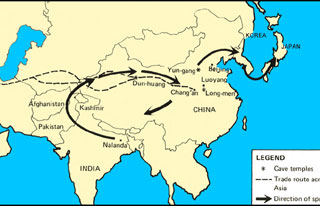 |
How Buddhism travelled to North Asia |
Tibetan Buddhism evolved in 600 CE, as a special aspect of Mahayana Buddhism, and spread nearly across the entire Himalaya region.
The European continent encountered Buddhism several times during its 2600 years of existence.
This was primarily due to the conquests of the Macedonian king, Alexander the Great, who conquered most of Central Asia. The Indo-Greek kingdoms, which emerged as a result, gave rise to the exchange of the Greek-Hellenistic and Indo-Buddhist culture. The Greco-Buddhist art is a fine example of this. Some of the Buddhist monks travelled on the trading routes from India even up to Greece. They were instrumental in spreading Buddha’s teachings. References to the earliest traces of Buddhism in Europe were made by the Greek Philosopher Plutach and also by the Milinda Panha (Buddhist Canon). Both described the earliest conversions, that of the Indo-Greek King Menander to Buddhism.
Saint John of Damascus translated the biography of Buddha into Greek in the 9th century, naming it "Balaam" and "Josaphat", and distributed it to the Christian population.
During the last two centuries, interest in Buddhism in the west increased amongst the intellectual, scientific and cultural communities. Thereby Buddhism spread in various ways through the different aspects of society. Hence, the scientist, Max Mueller made accurate German translations of the Sanskrit texts. Also, the famous German Author Herman Hesse, who wrote the novel "Siddhartha", was inspired by Buddha’s life. The German philosopher Schopenhauer was also influenced by Buddhism.
The Jesuit Pater Lassalle is one more example. He was a missionary in Japan and survived the a-bomb attack on Hiroshima. He learnt Zen-Meditation whilst in Japan and returned as a Christian Zen teacher to Europe. Nowadays in some catholic monasteries, Zen-Meditation is offered in seminars and workshops.
During the Vietnam war refugees came to Central Europe and America, rescued by charity organizations as “Boat People”. These people brought along with them, their Buddhist culture. For example, 120,000 of them, are now living in Germany. 60,000 of them belong to the Temple “Pagoda Vien Giac” in Hannover. Reverend Thich Nhat Hanh is a Vietnamese Zen Master, who escaped the war. He founded a Buddhist order for Vietnamese and Western disciples in France. He became a well known name for Buddhism and Inter-religious dialogue in the west, through his numerous publications.
Buddhism is not confined only to inter-religious dialogues. It also extend to dialogues between science and Buddhism. In contemporary times the gap between science and Buddhism is increasingly narrowing. Both have similar concepts of the cosmos.
Albert Einstein said “Buddhism [...] avoids dogmas and theology; it covers both the natural and the spiritual. … it is based on a religious sense aspiring for a meaningful unity from the experience of all things, natural and spiritual”.
Many Buddhist centres exist in Europe, North and South America, Australia, New Zealand. In contemporary times virtually all the major Buddhist traditions are represented, and continue to attract the interest of Westerners in all walks of life.
|
|
|
1. Right Vision
Baba explains that Right Vision is the first and foremost step. Without Right Vision nothing can be achieved. Right Vision (in some interpretations it is called Right Understanding) is to look on every situation with a Dharmic view.
|
|
|
The essential teaching of the Noble Eightfold Path is that we control our senses. When we control our senses, then we will see good in the world. Swami says:
Hence, Buddha declared that the first requisite is Samyak darsanam (Having the right vision). The implication of this statement is that, having been bestowed with the great gift of eyes, man should use them for seeing sacred objects and holy beings. But, on the contrary, by using his eyes to look at unsacred objects and evil persons, man fills himself with bad thoughts and becomes prey to evil tendencies.
What one sees influences the feelings in the heart. The state of the heart determines the nature of one’s thoughts. The thoughts influence one's life. Hence to lead a good life the first prerequisite is pure vision. Man has to cultivate a sacred outlook. As a result of looking at cruel, ugly, and wicked scenes man leads an animal existence.
The very first inquiry one should make is to ascertain what is pure, edifying, and godly that he should see. Whatever he sees leaves its imprint on man. Few realize the effects of this. (Divine Discourse, 5th Feb 1998)
This was the first lesson Buddha taught. Buddha wandered all over the country in search of spiritual peace and liberation. After many years of inquiry he came to the conclusion that the secret of spiritual wisdom was not to be derived from scholars or by study. He realized that spiritual understanding could only come from mastery of the senses. (Divine Discourse, 5th Feb 1998)
2. Right Thoughts and Feelings
Feelings and thoughts arise like a chain reaction triggered from what comes in through the senses. When we watch violent movies or a bloody political encounter on the news, if our mind is not well trained we tend to support one side or the other and perhaps would like to punish the "bad guys" – even when we know both sides are equally abhorrent. When an undisciplined mind is stimulated by scenes of violence, it predictably reacts with feelings and thoughts of further violence.
However, if we have made the effort to train the mind to remain peaceful, then we can be unaffected and remain centred in calm thoughts and feelings. Whenever anger, hatred or jealousy commandeer the mind and spawn negative feelings and thoughts, a sincere spiritual seeker can instead concentrate his vision on the good. |
|
|
Despite surface appearances, somewhere within every situation there is always something good happening. When we recognise this, we become more steady and balanced and our reactions can bring harmony and peace rather than further agitation. From Right Vision and Right Thoughts, Right Speech will arise.
The purification of our vision and the cultivation of sacred feelings are conducive to purity in speech, which in turn promotes harmony and an atmosphere of love and cooperation. Whenever an individual is thus transformed, society benefits from it as well. Only through the righteousness of every individual can a Dharmic community be built and sustained. A pure mind is essential for pure thoughts, pure vision and pure speech.
3. Right Speech
Speech is the most important aspect to every human contact. Sai says:
From developing sacred vision, man should proceed to samyak vachanam (sacred speech). Buddha declared that only sacred thoughts could lead to sacred speech. Buddha declared that the tongue should not be used recklessly to utter whateverone thinks. The tongue has been given to speak the truth, to amplify on what is sacred and pure.
The tongue has not been given to man to pamper the palate with delicious sweets. It is not given for talking as one likes. It is not to be used for causing displeasure to others. Nor is it to be used for indulging in falsehood. The tongue has been given to man to speak the truth, to be sweet to others, to praise the Divine and enjoy the bliss derived from such sacred speech. (Divine Discourse, 5th Febuary, 1998)
Buddha placed Right Speech before Right Action.
We should not only avoid lying, gossiping, harsh words and so on, but we should strive to maintain harmony in the community by being truthful, reliable and credible in our words. Through our speech we can build a society based on truth, trust and unity, or conversely, one of mistrust and isolation. |
|
|
Our speech should always be based on human values like fairness and integrity. Right Speech requires something more, however, as speech is often a reaction to someone else's words. Before we voice an opinion, we must listen carefully to the other person's feelings and needs. When we answer, we should include these in our response as well. This is the way of Right Listening. Only when we answer respectfully to the needs of the other are we able to foster peace in the society and dispel ignorance.
In order to listen attentively, comprehend another's viewpoint, and respond with compassion, we must first learn how to communicate in an appropriate manner. The following incident illustrates this point:
|
An American, who bases his peace work about non-violent communication in a spiritual context, states: “Certain ways of communicating alienate us from our natural state of compassion”. As an example, he relates an encounter which occurred when he visited the Deheisha Refugee Camp in Palestine. When he was recognized as an American, a few Muslims shouted slogans at him, like, “Murderer, child killer!” Being trained in the way of Right Speech, however, he reacted calmly and carefully.
First he verbalized their feelings and acknowledged their anger. He also accepted their expressed frustration that his government could utilize its resources for more humane objectives. They then mentioned their personal needs for housing and other basic amenities. The American questioned one individual whether he would like his living conditions to be improved? The man started to complain about the poor circumstances in which he and his family continually struggled. They felt ignored and neglected.
The American verbalized aloud the man’s feelings of despair and enquired if he needs to be better understood. Next the man began to grumble about the stark disparity between his children and American children. The American man reflected back the father's anguish for his children (i.e., no secure place to study or play, no schoolbooks, etc.) He voiced his understanding for the man's desire for an overall improved environment. The dialogue continued on in this manner, the Muslim man vocalizing his pain and frustration and the visitor listening compassionately for the underlying feelings behind each statement. He neither agreed nor disagreed and perceived his words not as an attack but as a gift from a fellow human being prepared to share his life with him. Once he felt understood, the self-same man, who called him a murderer at the outset, invited him for a Ramadan dinner.
When Right Speech is correctly practiced it builds bridges. As in the above example, to pacify a problematic situation we must extend awareness and compassion to all, no matter their feelings or opinions. Even when someone is rude, we should look deeper and handle the conflict in a sensitive and loving manner. Most often people just want to be heard and acknowledged. When we grasp this basic principle of communication and respond in an appropriate way, we can alter and pacify even stormy circumstances.
4. Right Action
|
|
When one is proficient in the first three steps, the fourth step of Right Action and the next two of Right Livelihood and Right Effort will manifest automatically. The first three steps are like the foundation and lower floors of a house which shape its form and define its overall character and appearance. Each succeeding floor is supported by the ones beneath it – the first three qualities – so if the lower floors are spacious and well constructed, the next ones will follow suit.
So, Right Action is founded upon the first three qualities. In Baba’s words:
Buddha emphasized goodness in action (samyak-karma). The mark of good action is harmony in thought, word, and deed. When there is no such harmony, the action belies what is said or thought. Buddha went on to declare that good action is conducive to good spiritual progress (samyak-sadhana). Good deeds constitute genuine spirituality. Mere formal worship or ritualistic practices do not constitute spiritual striving. These religious practices are good in a way but they do not constitute spiritual sadhana.
|
True spirituality consists in the unity of thought, word and deed in all their purity and sacredness. Buddha declared that when spiritual striving of this nature has been completed, there is samyak-jivanam (leading a pure life). (Divine Discourse, 5th Febuary, 1998)
5. – 8. From Right Livelihood to Right Concentration
The next four steps of the Noble Eight fold Path are Right Livelihood, Right Effort, Right Mindfulness and Right Concentration.
When we practice Right Livelihood in our profession, we avoid everything which can potentially harm other beings, whether selling weapons (or violent movies), meat, alcohol, drugs, polluted foods, unsafe products, etc. Further, we would naturally choose to stabilize our life, serve others, and contribute to justice and purity in society by practicing good business ethics, avoiding profiteering, and treating everyone fairly.
All this leads to Right Effort. Becoming increasingly aware of our selfish tendencies, we can then dissolve the three mental toxins of hatred, jealousy and greed and replace them with love.
Right Mindfulness will occur when we practice all these steps. Our mind becomes more steady and conscious of the divine presence. Right Concentration naturally follows as the final step.
As explained by Baba, Right Action leads to spiritual progress (samyak-sadhana) and steadies the mind. This results in a pure life. |
|
|
Right Action and a pure life thereby become integrated. The typical spiral effect of the Noble Eightfold Path becomes evident here. The progress which is made in our spiritual development bestows a steadier mind and equips us for Right Action founded on Right Vision, Thoughts and Speech.
"When You Fill Your Heart With Love…" – Baba
In this discourse, Swami tells us that the Noble Eight fold path can be easily followed when we fill our hearts with love.
|
|
(Buddha) stressed the need for Samyak Vak (sacred speech). Anudvegakaram Vakyam Sathyam Priya-hitham Cha Yat (one should speak only those words, which cause no annoyance to others and which are truthful, agreeable and wholesome). Whatever you speak should not cause any disturbance to others. It should be truthful as well as pleasing. You cannot always oblige but you can speak always obligingly. Sacred speech is the manifestation of divinity. God exists in the form of Sabda Brahmam (sound principle).
…Under any circumstances, do not let your speech be tainted by harshness. Never become agitated. When you understand that all are one, there will be no chance to get agitated. All bodies are like mirrors, showing you your own reflection in them. How can you be angry with your own reflection? You should speak with love. There is no divinity greater than love. When you fill your heart with love, your thoughts, vision, words and deeds will be suffused with love. (Divine Discourse, 5th Febuary, 1998)
|
The Goal Of The Noble Eightfold Path Is Nirvana
Nirvana is not an abstract place or a secret formula. In the Buddhist Heart Sutra, it is said, that ‘Form is Void and Void is Form’. This means that it is both with and without attributes and therefore beyond our logical understanding. We can perhaps understand this better by the example of the Bodhisattva vow. When someone takes this vow, they promise to stay in the world and help others until every living being attains enlightenment. In this context it requires one to eradicate any distinction between nirvana and the world. This distinction is an obstacle in our mind, a dualism created by the desire for enlightenment.
Baba speaks about Nirvana in this way:
Today man aspires to attain mukti (liberation). What is mukti? It is not the attainment of a heavenly abode. Mukti means freedom from suffering. You need to have mukti at three levels – body, mind and soul. For example, you are hungry. When you eat food, your hunger is satiated. This is also a kind of mukti. You are suffering from a disease. You take a medicine and get cured. This is also mukti. All this is related to the body.
At the mental level, mukti means controlling the vagaries of the mind. But true liberation lies in understanding the principle of the Atma, which neither comes nor goes. This is termed as Nirvana. (Divine Discourse, 7th May, 2001)
In 1997 Swami also said:
Buddha's emphasis was entirely on purity in every aspect of daily life. Purity in vision, purity in thought, purity in speech and purity in action. He considered the spirit of sacrifice as true yajna. Sacrifice is the means for attaining Nirvaana (freedom from the bondage of mundane existence. (Divine Discourse, 15th May, 1997)
|
|
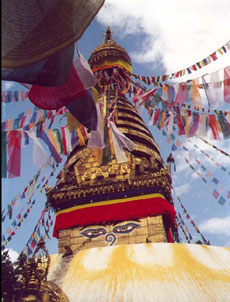 |
Sayambunath, Kathmandu |
|
Nirvana is that which is permanent –we will neither find it in the future nor in the past. It is not owned by Buddhists, by Hindus, nor by any other sect or religion. It is the very essence of every living being. When our mind is steady and directed towards oneness, we will be able to reach liberation here and now. In Buddhism it is said that the way itself is the goal. Control of the senses itself is nirvana.
THE SILAS – GUIDELINES ON THE NOBLE EIGHTFOLD PATH
The Silas (training rules) are an aid for Buddhists following the Noble Eightfold Path. Normally people undertake five rules, although some who are keen will undertake all ten.
- To refrain from harming living creatures (killing).
- To refrain from taking that which is not freely given (stealing).
- To refrain from manipulative oppression of basic human rights due to social inequalities.
- To refrain from improper speech (lying, harsh language, slander, idle chitchat).
- To refrain from intoxicants (such as alcohol or drugs) which lead to loss of mind control.
- To refrain from exposing others’ mistakes and short comings.
- To refrain from elevating oneself at the expense of denigrating others.
- To refrain from withholding the free flow of Dharmic Abundance.
- To refrain from being subjugated by anger.
- To refrain from malicious remarks about the Three Jewels
BUDDHA’S DISCIPLES
Buddha brought his teaching to the entire cross section of the populace, whether royalty, worker, or outcaste, whether rich or poor. He empathized with each and every person who opened up to him. Some followed him everywhere, yearning to develop their understanding of his teachings.
The disciples, through their example, manifested Buddha's teachings. Their transformation bore witness to Shakyamuni Buddha's greatness. The accounts of these disciples have been told over the centuries and convey many lessons. Two of the disciples were Ananda, the step brother of Buddha, and Sariputra. The following two stories illustrate the qualities of these disciples.
|
|
|
Ananda - The Compassionate Disciple
Ananda was very dear to Buddha since their childhood days. It is said, that he never attained enlightenment during the lifetime of the Buddha. However, very shortly after the Buddha’s Parinirvana, he did realise the ultimate truth. In the Buddhist tradition, he represents compassion. He also had the most retentive memory and it is due to him that Buddha’s teachings have been recorded so thoroughly. Ananda joined the Sangha as a child, and like his brother he refused to become heir apparent of the Shakya kingdom.
Once Ananda approached the Buddha and remarked that "half of the dispensation is based on friendship, companionship and association with the good." To which the Buddha replied, "Dear Ananda, do not say so. Not half, but man's entire life is established on friendship, companionship and association with the good."
The Buddha repeated his vision in the Metta Sutra, one of the core texts in Buddhism. This is what should be followed by one who is kindhearted and who knows the paths of peace:
| |
Let them be able and upright,
straightforward and gentle in speech.
Humble and not conceited.
May they be content and easily satisfied,
unburdened with duties and frugal on their ways.
Peaceful and calm, and wise and skillful.
Not proud and demanding in nature.
May they be wise, with their senses calmed,
not arrogant and without desire.
May they do nothing that the wise would later reprove.
May all beings be happy.
May they live in safety and joy.
All living beings, whether weak or strong, the great or the mighty,
medium, short or small, seen or unseen, near or distant,
born or to be born, may they all be happy.
Let no one deceive another or despise any being in any state,
let none by anger or hatred wish harm to another.
As a mother watches over her child,
willing to risk her own life to protect her only child,
so with a boundless heart should one cherish all living beings,
radiating kindness over the entire world.
Standing or walking, sitting or lying down,
during all one's waking hours may one remain mindful of this heart
and this way of living that is said to be the sublime abiding.
Unattached to speculations, views and sense desires,
the pure hearted one, with clear vision,
being freed from all sense desires,
will never be reborn in the cycles of suffering. |
|
Sariputra, the Wise and Humble Disciple
The handsome young Sariputra was a renowned scholar in the academic field. However, he considered his wisdom to be peerless and that none could qualify to teach him until he met the Buddha.
Sariputra was Buddha’s chief disciple, and despite his own deep wisdom, he always followed and obeyed the Buddha's instructions. Among all His disciples, Buddha trusted Sariputra the most. When His son, Rahula, joined the Sangha, Buddha asked Sariputra to be his mentor.
Once, Rahula accompanied Sariputra to beg for food. He returned to the monastery with a sullen look. When Buddha enquired why he was unhappy, the young Rahula replied resentfully, "Buddha, when we beg for food the devotees always give good food to the elder monks but they usually offer food with no nutritious value to the younger monks. Everyone needs good food to maintain their health. Our elders neglect to take care of us when they receive the good food."
 |
Alms giving in Luang Prabang |
|
|
The Buddha knew very well that nutritious food was necessary to maintain health and a healthy body was very important for monks because if they were weak they would not be able to concentrate on their meditation practice. However, the Buddha lectured Rahula for being too preoccupied about food when he should be focused on his meditation practice.
After Rahula left, Sariputra was summoned to see the Buddha. "Sariputra, do you know that you have eaten unclean food today?" Sariputra quickly threw up the food taken on that day and said, "Lord Buddha, ever since I became your disciple I have always been following the rules of begging prescribed by you and would never dare to accept any unclean food." |
Buddha then clarified, "Sariputra, I know you have been observing the rules of conduct, but one cannot be self-centered in the Sangha. Rules should be fair to everyone and the benefits should be equally shared. It is the responsibility of the elders to take good care of the younger monks, even where begging for food is concerned."
Sariputra was not angry and gratefully accepted the teachings of the Buddha.
Buddha’s Path Requires Individual Responsibility
In the time of the Buddha, many people believed that rituals could grant them liberation. Buddha, however, discovered that this was untrue. He repeatedly emphasized that liberation is attained only by adhering to the path of Dharma. He shifted the responsibility back to the individual. The individual was responsible for his development, his Right Vision and Right Action. Nobody else can undertake this responsibility. Like Buddha, Baba also points out that none can assure liberation for us. Only self-effort will lead us to it.
Buddha went on to declare that good action is conducive to good spiritual progress (samyak-sadhana). Good deeds constitute genuine spirituality. Mere formal worship or ritualistic practices do not constitute spiritual striving. These religious practices are good in a way. But they do not constitute spiritual sadhana.
True spirituality consists in the unity of thought, word and deed in all their purity and sacredness. (Divine Discourse, 5th Febuary, 1998)
Baba also explains that love is the way to God and that love and life are the best teachers.
|
|
|
There is no need for you to follow this person or that person in the search for a Guru. The heart full of compassion is the altar of God. Nature is the best preacher. Life is the best teacher. Fill yourselves with awe and reverence at the handiwork of God, the manifestation of His Power and Glory that is called the World. This is enough instruction and enough inspiration for you. (Divine Discourse, 14th January, 1973)
Our speech is more authentic when we adhere to our own experiences and avoid unsubstantiated references. Buddha once reprimanded a disciple, who lavished praise on him. Buddha often said that there are other Buddhas, too, and that he was not the only teacher who was leading disciples to the goal of liberation. Swami related a story about this.
Once, Buddha was travelling from village to village giving spiritual discourses. One day, he felt tired and asked one of his disciples to address the gathering. He went inside to meditate and take rest. During the course of his speech the disciple said, ‘In this world, there has never been a spiritual master greater than our master Buddha and there will not be another like him in future.
The audience gave a thunderous applause. On hearing this, Buddha came out. One of the disciples told him the reason for the people's joyous applause. Buddha smiled and called the disciple who delivered the lecture. ‘What is your age?’ he asked. The disciple said he was thirty-five-years-old. ‘How many kingdoms have you visited so far?’ Buddha asked him. The disciple said he had visited only two kingdoms. Buddha said, ‘You are thirty-five-years-old and have seen only two kingdoms. You have not understood the present completely. Then how can you say anything about the past and the future? It is meaningless to say that a master like Buddha was never born before and will never be born again. Many Avatars and sages have taken birth in this sacred land of Bharat. Many more Avatars and noble souls will be born here in future also. There are many noble souls in this world; I offer my respects to all of them…’
|
|
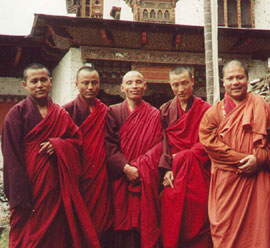 |
A Scene From Bhutan |
|
This was the teaching of Buddha. Character is important, not money. Bliss can be attained only through control of senses, not through penance, japa, or meditation. Neither by penance nor by going through scriptures nor by having a dip in holy rivers can one attain liberation. Only by serving noble souls can one cross the ocean of Samsara. There is no easier path to peace and bliss other than controlling one's own senses. (Divine Discourse, 30th May, 1999)
THE JATAKA STORIES
The Jataka stories are an inherent part of Buddhist culture. They are a collection of stories enjoyed both by children and adults. They are easy to remember and their insights and wisdom are easily grasped. Some are based on historical events and some are fictional accounts. Over millennia the purpose of the Jataka stories has been to cultivate moral conduct and good behaviour. The Buddha himself used Jataka stories to explain concepts like karma and reincarnation and to emphasise the importance of certain moral values, just as Baba conveys spiritual teachings through Chinna Katha.
These stories are even more relevant in the fragmented societies of today. This applies especially for children for whom guidance is much needed in contemporary times. All Jataka stories are parables for correcting our behaviour. Such stories play an enormous role in the cultivation of peace and generosity in all societies. In India, these and other similar stories were a principal instrument in the socialisation of children, discouraging them from selfishness and laying foundations for family and community solidarity. Jataka stories speak eloquently of those human values which contribute to harmony, happiness and progress.
Jataka and other similar stories travelled far and wide by word of mouth along caravan routes and contributed to the literature of Arabia (Arabian Nights), Italy (Boccaccio’s tales), Greece (Aesop’s Fables), Britain (Chaucer’s Canterbury Tales) Japan (Zen stories), Persia and China. Here is a typical Jataka story.
God Is Where Love Is!
|
|
“Once, three aged monks lived in a monastery, amidst cedar trees, on a remote hill surrounded by mountains. They dutifully worshipped the Buddha, and all the Patriarchs. Daily they practiced their rituals, chanted the Sutras and meditated. However as they progressively aged, they harboured a gnawing concern.
They acutely desired to impart to the next generation the tradition and teachings of Lord Buddha and also their own knowledge. However, they were painfully aware that is was very long since anyone had visited the monastery in pursuit of the spiritual path. They increasingly feared that their advancing age and impending deaths would thwart the continuity of their spiritual legacy. |
Eventually they set out to consult a wise man. A day and a half later, they reached his hermitage in the mountains. After his warm welcome and exchanging pleasantries they submitted their concerns to him.
Responding with a knowing smile and loving eyes, he said, “Please give me some time. It is not an easy question and requires reflection. I need to meditate upon it.”
So he began meditating and the monks sat and waited. Nearly two hours later he startled them by suddenly opening his eyes, and exclaiming” I saw…I saw…oh, Buddha!”
The monks clamoured unanimously to know, what he had seen. The wise man, silent and smiling, just gazed at them. Then, with a wave, he silenced them. Quieted, the monks waited with bated breath.
Pausing a while, the wise man revealed, “I had a profound vision. I saw Buddha Amitabha, the compassionate Buddha.”
The monks were awestruck, deeply moved by such a blessing. The wise man continued, “There is something more. I saw, that one of you three is the Buddha Amitabha”. The monks cried out in astonishment, “Who is it?”
The wise man replied, “I am sorry, but I only saw that one of you is the Buddha. I could not specifically identify who.”
The monks were overjoyed that one amongst them was the Buddha Amitabha, the compassionate Buddha. Profusely thanking the wise man, they departed. |
|
|
Throughout their return journey, silently they all pondered deeply upon who amidst them could be the Buddha Amitabha?
The first monk was thinking, "Is it the monk behind me? He knows so much about Buddha’s teachings, he is a walking dictionary. But on the other hand, he is so much older than I am, his skull is already visible. No he cannot be the Buddha Amitabha. And the other monk cannot even cook properly. No, actually, the only one is myself – yes, I must be the one, who the wise man could not identify."
The second monk was busy asking himself the same question. He thought "The monk in front of me can recite all the sutras very well but he does not seem to understand them well. And he has a broken nose from a fight in his teenage years. No, he cannot be Amitabha Buddha. And the other one, behind him? He shuffles along with us, probably busier with the mosquitoes than with meditation. Only I can be the one. It must be myself."
The third monk was asking himself whether the first one could be the Buddha. He reflected, "But his breathing is so loud during meditation and the other one can not even sit silently for an hour. No, I must be the Amitabha Buddha." |
|
|
So their reflections resulted in each monk concluding, that he himself was the Amitabha Buddha. They each felt an elevated sense of self and a deeper commitment and responsibility towards their own spiritual endeavours and excellence. Each one assumed the role of Amitabha Buddha. No one openly claimed that he was the Buddha, believing that time itself would reveal their reality.
They all resumed their monastic life, daily rituals and duties. But as time passed by a profound change took place. When they meditated and the first monk started to sniff or cough, the other two smiled silently. When the third monk brought the food to the table, the others ate it with so much loving acceptance. Nobody complained anymore.
|
|
Mutual tolerance was increasing daily between them. Signs of peaceful change accumulated slowly but surely. The atmosphere of the monastery began to transform, and gradually filled with love.
One year later, a young man visited the monastery and rested a while there. Gradually from then on people began to visit and stay for a while. Some months later the first disciple arrived. The monastery was once again vibrant and joyful.
When we perceive everything in us as divine, we can then attain liberation. Love is the way to attain liberation – this is the fundamental truth.
Baba expounds the essence of Buddha’s teachings as follows:
|
Man can get limitless powers through love of God…Man’s love is like an atom when compared to divine love, which is infinite, eternal, and nectarine. It is foolishness and ignorance on the part of man to think that he knows everything without understanding the principle of Love. He should see through the eyes of love, hear through the ears of love and cultivate the feelings of love. (Divine Discourse, 30th May, 1999)
THE LAST WORDS OF THE BUDDHA
There are various versions of the last moments and words of the Buddha. Throughout the centuries these accounts have been continually revised. The following is one such version.
Forty-five years after he attained enlightenment, Lord Buddha entered Parinirvana at Kushinagara, laying between two shala trees. Like the radiance of the enchanting evening sun, the Buddha radiated an unusual brilliance. The Buddha lay on a bed made by Ananda.
|
|
As darkness fell, the shala trees burst into bloom, showering a rain of flowers on Buddha's body.
The moon quietly shone on the shala grove while the quiet and lofty mind of the Buddha shone on all the people in the grove. It was a touching yet solemn scene. Everybody wept, including the enlightened sages. Ananda was especially sad and cried tearfully.
However, crying would not help mankind! The most important task was to consult the Buddha for retaining Dharma forever. They deliberated and elected Ananda to represent them to pose their last queries to Buddha. |
First, when Lord Buddha enters Nirvana, who shall be the master?
Second, when Lord Buddha enters Nirvana, how shall we live?
Third, when Lord Buddha enters Nirvana, how should we treat evil people?
Fourth when Lord Buddha enters Nirvana, how do we propagate the Teaching?
In his usual compassionate tone, the Buddha replied,
"All of you must remember to take the precepts as your master and take the Dharma (Truth) as your refuge; in this way you will ensure the continuance of the Dharma.”
After hearing Buddha's words, everyone was moved.
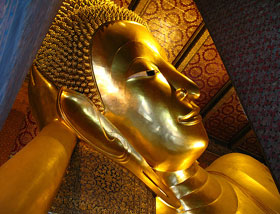 |
Wat Pho, Bangkok, Thailand |
|
|
Baba also narrated Buddha’s last words:
In his last moments, Buddha summoned His stepbrother Ananda to impart to him His final message…Placing His palm on the head of His younger brother, Buddha said:
“My dear child! I came to the world to teach (the Truth). If anyone asks, ‘Where is God?’ the answer is: ‘He is everywhere’. Truth is God. Speak the Truth. Do not harm anyone. Recognize that the highest dharma is non-violence, ahimsa.” (Divine Discourse, 5th February, 1998)
|
BUDDHA POORNIMA
Buddha Poornima or Vesakh is an auspicious Buddhist festival. It is the first full moon night of May. Significantly Buddha was born, attained enlightenment and entered into Parinirvana on the first full moon night of May, symbolically demonstrating that we are born and die each moment and in the same moment we are carried by eternity.
Baba has commented on Buddha Poornima in this way:
Embodiments of Love! We are celebrating today Buddha Poornima, or Buddha Jayanthi. What does Poornima (full moon) signify? It signifies wholeness. When the mind is filled with love, it achieves fullness. As long as the mind is filled with darkness (evil thoughts) there is no meaning in celebrating Buddha Poornima. Get rid of this darkness. Without the light of love in the heart, what use is there in having illuminations outside? Light the lamp of the Divine in your minds. Banish hatred and envy from your hearts. Man is the victim of two evil planets: attachment and hatred. To escape from their grip, the only way is to cultivate love. (Divine Discourse, 15th May, 1997)
Buddha Poornima 2006 In The Divine Presence
Devotees have been blessed by Bhagavan to celebrate Buddha Poornima in His presence every year. Buddhists from 14 countries converged at Brindavan, Whitefield on May 13th, this year (2006) too and had a very memorable two days of celebrations in the presence of the Living Sai Buddha. 8 monks were present from Sri Lanka and Indonesia, as well as many dignitaries, in particular from Sri Lanka. The day began with Bhagavan being escorted to the dais by 12 children from Indonesia.
Scenes From Buddha Poornima Celebrations, 2006 in the Divine Presence in Brindavan, Bangalore |
|
|
|
|
Then followed some beautiful bhajans sung by overseas devotees which pleased Swami. Dr. Jumsai then gave a speech commenting that the Sri Sathya Sai School in Thailand had been hailed as the best Buddhist school in the country. After lunch was served to the 1100 delegates, the evening began with bhajans followed by a speech by Dr. Reddy who commented on the universality of the Buddha’s teachings. Sri Krishnaputra spoke next and related how, with Swami’s grace, he had been able to open a Sai centre and a school in Indonesia . Then followed the Discourse by Bhagavan in which He said,
During the course of his (Buddha’s) journey, he once reached a town and met a holy man. The holy man told him that the cause of his anguish was actually within him, and it was his anguish that was coming the way of his self-realisation. So saying, he gave a talisman for protection and asked him to wear around his neck. At this point of time, (Bhagavan materialised that talisman and showed it to the congregation amidst a thunderous applause).
This was the talisman given by the sage to Siddartha. When Siddhartha put the talisman around his neck, all his anguish disappeared instantaneously. Then he started doing intense penance which went on for a long time. He kept questioning himself, “Who am I?” “Am I the body? Am I the mind? Am I the Buddhi (intellect)? Am I the Chittha (mind-stuff)?” He came to the conclusion the he was neither of these. Ultimately, he experienced the truth, “I am I”. Till the last moment of his earthly sojourn, Buddha had the talisman around his neck. When he shed his mortal coil, the talisman disappeared.
|
|
|
Siddhartha advocated the practice of meditation. What is that you have to meditate upon? What is meant by meditation? Does it mean concentrating upon a particular object? No, no. That is not meditation at all. To meditate upon the principle of “I am I” is true meditation. No other Sadhana (spiritual practice) can match this… Buddha recognised the principle of unity and based his life on this truth. Under the direction of many yogis, he had performed various kinds of meditation and penance, but ultimately found them to be a mere waste of time as none of these could lead him to the ultimate experience of oneness.
|
|
He regretted having wasted his time in such a manner. One should find fulfillment in life by making proper use of the time. This is the primary duty of man.
Buddha could attain the experience the unity of all creation. There was total transformation in him once he attained the vision of Ekatma (oneness of the Atma). He realised that all worldly relations like mother, father, wife, children were false. He transcended body consciousness. That is why he earned the appellation Buddha (enlightened one).
Truly speaking, Buddha is not just one individual. All of you are Buddhas. You will see unity everywhere once you understand this truth. There is unity in the apparent multiplicity. When you are surrounded by many mirrors, you see a number of your reflections. Reflections are many, but the person is one.
|
After Bhagavan’s discourse there was a dance performance from Indonesia and another drama by the Sai Youth of Singapore, thus concluding the day’s programme. On the second day a choir from Malaysia sung some beautiful Chinese songs and then Swami blessed the food to be given out as Narayan Seva. Then followed some amazing drumming from Sri Lanka and lastly a dance from Indonesia. So it was celebrations at it best in the divine presence. [To read a very detailed account of the celebrations along with lots of pictures, go to Prasanthi Diary by clicking here].
You could see there was an inexplicable joy in the hearts of everyone present. They had experienced something which they had never experienced before, something which they cannot get anywhere else on earth. The living presence of Divine Love on Mother earth, then as Buddha and now as Sai, are acts of supreme Divine Compassion. Let’s wake up to it. Rejoice and redeem our lives.
The Author, Jens Eymann, studied Rinzai Zen for five years under Reverend Rei Ho Hatlapa Roshi (Germany),
who is the Dharma Successor of Oi Saidan Roshi ( Japan ).
Dear Reader, how did you like this cover story? Did it inspire you? Do you have any suggestions for our future cover stories? Please let us know at h2h@radiosai.org. Please mention your name and country when you write to us. Thank you for your time.
- Heart2Heart Team.
|










